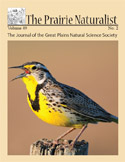Great Plains Natural Science Society

The Prairie Naturalist
Low Reproductive Success of Mallards in a Grassland-Dominated Landscape in The Sandhills of Nebraska
Date of this Version
3-2008
Document Type
Article
Citation
The Prairie Naturalist 40(1/2): March/June 2008, pp 1-13
Abstract
The Sandhills of Nebraska comprise approximately 5,000,000 ha of native grassland interspersed with numerous groundwater-fed wetlands. A substantial population of the mallard (Anas platyrhynchos) nests in this region. Previous investigations of nest survival probability of ducks in the Sandhills have estimated surprisingly low rates of nest survival for a grassland-dominated landscape. These investigations were conducted on public lands and most nest searching took place near wetlands where activity of nest predators might be highest. We predicted that mallards would nest at varying distances from wetlands and that survival probability of a representative sample of duck nests would increase with distance from wetlands. We decoy-trapped and radio-marked 71 female mallards, 32 during the 2005 nesting season and 39 during the 2006 nesting season, and monitored their individual choice of nest habitats, their survival during the nesting season, and survival of their nests. Mallards nested in various habitats, both near and far from wetlands. Nest survival probability (S = 0.03, SE = 0.02) was low relative to other studies regardless of distance to wetlands. Survival of females during the nesting season (S = 0.84, SE = 0.08), however, was high relative to other studies. This pattern could have resulted from the combination of a diverse community of nest predators, few predators of nesting females, and a population of largely second year females that put little effort into nesting.
Included in
Biodiversity Commons, Botany Commons, Ecology and Evolutionary Biology Commons, Natural Resources and Conservation Commons, Systems Biology Commons, Weed Science Commons

